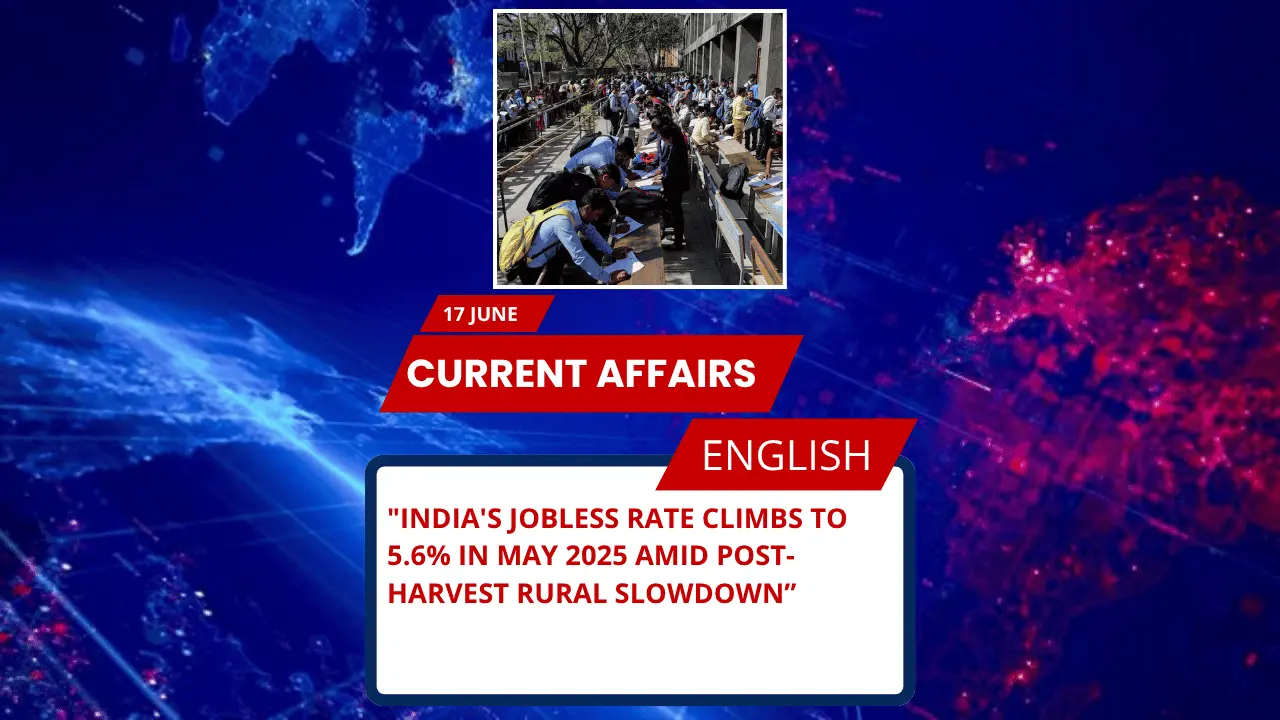
Key Points for SSC, UPSC & Other Government Exams
- India’s unemployment rate rose to 5.6% in May 2025, up from 5.1% in April 2025.
- Rise in joblessness is linked to the post-harvest decline in farm jobs.
- Urban youth (15-29 years) unemployment: 17.9% in May (up from 17.2% in April).
- Rural youth unemployment: 13.7% in May (up from 12.3% in April).
- Share of rural workers in agriculture fell from 45.9% (April) to 43.5% (May).
- Female labour force participation dipped to 27.8% from 28.8%.
- Manufacturing growth slowed to a 3-month low in May 2025.
Detailed Analysis
India’s Unemployment Situation in May 2025
India’s overall unemployment rate touched 5.6% in May 2025, as reported by the Ministry of Statistics. This marks a rise from 5.1% in April 2025. The increase comes in the wake of declining agricultural employment after the harvest season ended, pushing many rural workers out of jobs.
Urban & Rural Youth Employment Trends
Unemployment among urban youth (15-29 years) climbed to 17.9% in May, up from 17.2% in April. This highlights the persisting challenges in urban job markets. Similarly, rural youth unemployment rose to 13.7% compared to 12.3% the previous month.
The share of rural workers in agriculture reduced from 45.9% to 43.5% within a month, indicating a shift towards manufacturing and services.
Gender Impact
The data also reveals that women in rural areas faced a significant hit. The labour force participation rate (LFPR) for women fell to 27.8% in May, from 28.8% in April, largely due to fewer job opportunities in the agricultural sector post-harvest.
Manufacturing & Economy Outlook
India’s manufacturing sector showed signs of slowing down. The growth rate fell to its lowest in three months in May, impacted by weakening demand, price pressures, and geopolitical tensions.
Meanwhile, India’s economy grew at 7.4% in Q4 FY2024-25 and is projected to grow at 6.5% in FY2025-26.
Facts About India for Exams
- Country: India
- Capital: New Delhi
- Prime Minister: Narendra Modi (as of June 2025)
- President: Droupadi Murmu (as of June 2025)
- Currency: Indian Rupee (INR)
- GDP Growth (Q4 FY25): 7.4%
- Projected GDP Growth (FY26): 6.5%
Possible Exam MCQs
Q1. What was India’s unemployment rate in May 2025?
A) 5.1%
B) 5.6%
C) 6.0%
D) 4.9%
Answer: B) 5.6%
Q2. What was the unemployment rate among urban youth (15-29 years) in May 2025?
A) 17.9%
B) 16.5%
C) 17.2%
D) 18.5%
Answer: A) 17.9%
Q3. The rural share of employment in agriculture declined to what percentage in May 2025?
A) 43.5%
B) 45.9%
C) 47.0%
D) 42.0%
Answer: A) 43.5%
Q4. India’s manufacturing growth in May 2025 hit a low due to which reason?
A) Strong demand
B) High exports
C) Weak demand and geopolitical tensions
D) Rising farm jobs
Answer: C) Weak demand and geopolitical tensions
UPSC Style FAQs with Model Answers
Q1. What are the key factors contributing to the rise in India’s unemployment rate in May 2025? Discuss in about 150 words.
Answer:
India’s unemployment rate rose to 5.6% in May 2025, up from 5.1% in April. The primary factor behind this rise was the seasonal decline in agricultural employment following the harvest season. This post-harvest slowdown particularly affected rural areas where the share of workers engaged in farm activities fell to 43.5% from 45.9%. The manufacturing sector, instead of absorbing this surplus labour, showed signs of deceleration due to softening demand and geopolitical tensions, further limiting job creation. The impact was more pronounced among women and youth, as reflected in a decline in female labour force participation and rising joblessness among young workers, both rural and urban. Therefore, the interplay of seasonal rural trends and structural industrial challenges contributed to the uptick in joblessness.
Q2. How does seasonal employment in agriculture influence India’s rural unemployment trends?
Answer:
Seasonal employment patterns in agriculture significantly shape rural unemployment trends in India. During peak agricultural activities such as sowing and harvesting, rural employment levels rise as demand for labour surges. Conversely, once the harvest period concludes, the need for farm labour sharply falls, leading to temporary job losses. This cyclical nature was evident in May 2025, when the rural unemployment rate rose due to a post-harvest decline in farm work. Such seasonal fluctuations highlight the vulnerability of rural labour to agricultural cycles and the urgent need for diversification towards non-farm rural employment to stabilize rural livelihoods across the year.
Q3. Evaluate the role of the manufacturing sector in absorbing surplus rural labour in India.
Answer:
The manufacturing sector in India holds the potential to absorb surplus rural labour, especially during periods when agricultural demand for workers declines. However, this transition faces multiple challenges. In May 2025, for example, manufacturing growth slowed to a three-month low due to weakened demand and global uncertainties, limiting its capacity to generate employment. While there has been a gradual shift of rural workers from farm to non-farm sectors, the pace has been insufficient to offset seasonal unemployment in agriculture. Strengthening manufacturing through policy measures, infrastructure development, and skill enhancement remains essential to effectively integrate surplus rural labour into more stable employment avenues.







